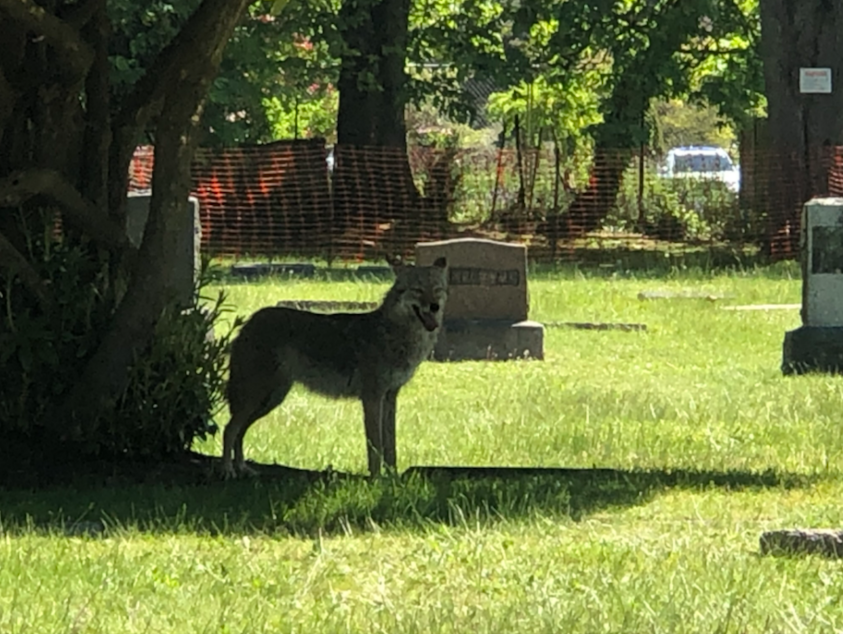It's coyote o'clock in Seattle. Should you bring your cats in?

In Ballard, three blocks from the train tracks, parts of Mr. Garibaldi’s body were found unceremoniously discarded next to his home.
In Meadowbrook, Willie was killed near the top of a ravine.
And in Bitter Lake, Tiger’s hindquarters were found in a yard after he didn’t come home for breakfast.
Mr. Garibaldi, Willie, and Tiger are Seattle cats who were killed and eaten by coyotes, leaving their owners distraught and distrustful of these wild, and increasingly urban, dogs.
Stories about cats being devoured by coyotes have been shared on NextDoor and between neighbors, leading me to fret: Were my kitties, Cleocatra and Atlas, safe?
The answer is yes, so long as I bring them in at night.
Coyotes do not appear to be preying on cats as much as it seems. Sam Kreling, a doctorate student at the University of Washington, and a researcher with the Seattle Coyote Study, said that of 600 coyote feces samples she has collected in the city, just one definitively included cat parts.
“It had a claw that was not from anything else, so it had to be a cat,” Kreling said.
Animal hospitals said the same thing: They rarely saw cats killed by coyotes, although perhaps people wouldn’t bring in their dead cats.
Kreling spends hours walking the greenspaces of Seattle, looking for coyote scat (poop) to analyze.
“From a visual assessment, they seem to be eating a lot of rats and rodents, and some rabbits, and a lot of fruit, especially during the summer,” Kreling said.
They especially like cherries, she said. “Whenever the cherries are blossoming and starting to drop their fruit, you'll see all these scats that are just like 40 different cherry pits.”
On a walk around the Union Bay Natural Area, Kreling pointed out a pile of coyote scat. It looked like clay mud, gray in color, with hair and bones in it. It had probably eaten a rodent or a rabbit, Kreling said.
Coyotes are opportunistic, she said, and will eat whatever is around them. And yes, that might include pets, although probably not as often as neighborhood banter would suggest.
“For one, cats fight back,” Kreling said. “I wouldn't want to go catch a cat if I'm going to get swiped in the face. Cats are also relatively good at evading predators. They're predators themselves and they know how that works.”
The carnivore spotter website, which allows anyone to upload a report, shows a trend of coyotes reported mostly in north and northwest Seattle. Oddly, very few sightings in West Seattle.
Though she's never actually spotted a coyote at these parks herself, Kreling said Seward Park, Golden Gardens, North Seattle College, and Hills of Eternity Cemetery are some of her best field sites.
With the scat samples, Kreling hopes to learn more about the coyotes: How many coyotes live in Seattle? Do urban coyotes differ genetically from rural ones (she believes city coyotes may be bolder)? And what are they eating?
A nationwide study found that cats make up 13% of the wild dog’s diet. A small study out of Tucson, Arizona, found that cats made up 42% of their diets. Kreling doubts the percentage is that high here, given Seattle’s rat and bunny population.
(Someone on NextDoor reported seeing a coyote eat seals, and even provided photo evidence of the mom seal and her pups running away!)
There was another story I’d heard on Facebook: Coyotes had a den at Crown Hill Cemetery, just south of the Dick’s burger joint on Holman Road.
Phillip Howell, the cemetery manager, said he had heard that rumor, too, but that wasn’t true.
“They live at Carkeek,” he said, referring to the sprawling green space due north. “We are a truck stop on their way into the neighborhoods.”
The coyotes follow the train tracks, he said, which would explain why Mr. Garibaldi, who lived three blocks from the train tracks, became prey.
“The local coyote is a common sight here,” Mr. Garibaldi’s owner, Karen Anderson, wrote.
“I often see him trotting down alleyways at dusk, sometimes carrying a squirrel. But the other day, at 1 p.m., he was trying to get at my neighbor’s chickens, who were putting up a terrible racket.
"When the neighbors came out and drove him off, the coyote trotted past the plumbers who had their truck parked in front of our house — they were astonished to see a coyote out and about at mid-day and walking just a few feet away from them.”
Anderson has lived in Sunset Hill for 21 years, she said, with coyotes passing through on occasion.
“But absolutely nothing like what we have now,” she said. “This is far too many near-tame coyotes.”
While I have seen coyotes running about midday, they are out most often dusk to dawn, with most reports of them out around 9 p.m.
I am less nervous than when I started reporting, but I still keep my cats in at night. When they paw at the door, demanding to be let out for a nighttime adventure, I tell them, “No way. It’s coyote o’clock.”
Web story by Isolde Raftery.






